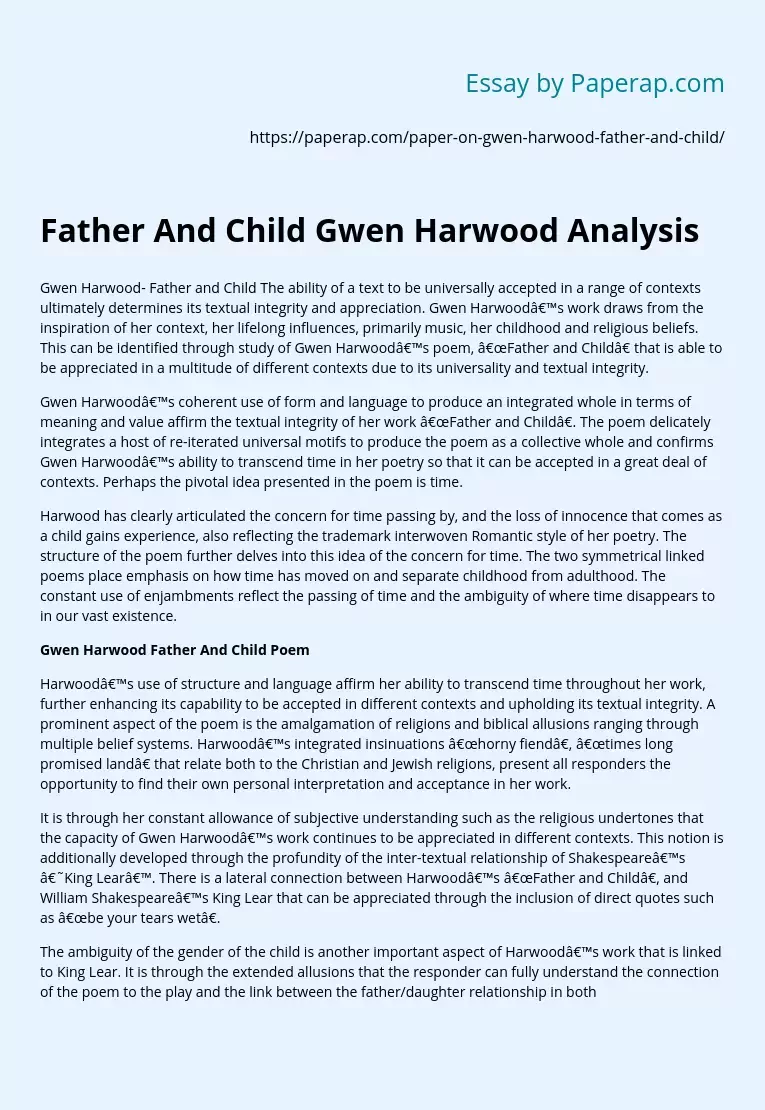Gwen Harwood- Father and Child The ability of a text to be universally accepted in a range of contexts ultimately determines its textual integrity and appreciation. Gwen Harwood’s work draws from the inspiration of her context, her lifelong influences, primarily music, her childhood and religious beliefs. This can be identified through study of Gwen Harwood’s poem, “Father and Child” that is able to be appreciated in a multitude of different contexts due to its universality and textual integrity.
Gwen Harwood’s coherent use of form and language to produce an integrated whole in terms of meaning and value affirm the textual integrity of her work “Father and Child”.
The poem delicately integrates a host of re-iterated universal motifs to produce the poem as a collective whole and confirms Gwen Harwood’s ability to transcend time in her poetry so that it can be accepted in a great deal of contexts. Perhaps the pivotal idea presented in the poem is time.
Harwood has clearly articulated the concern for time passing by, and the loss of innocence that comes as a child gains experience, also reflecting the trademark interwoven Romantic style of her poetry. The structure of the poem further delves into this idea of the concern for time. The two symmetrical linked poems place emphasis on how time has moved on and separate childhood from adulthood. The constant use of enjambments reflect the passing of time and the ambiguity of where time disappears to in our vast existence.
Gwen Harwood Father And Child Poem
Harwood’s use of structure and language affirm her ability to transcend time throughout her work, further enhancing its capability to be accepted in different contexts and upholding its textual integrity.
A prominent aspect of the poem is the amalgamation of religions and biblical allusions ranging through multiple belief systems. Harwood’s integrated insinuations “horny fiend”, “times long promised land” that relate both to the Christian and Jewish religions, present all responders the opportunity to find their own personal interpretation and acceptance in her work.
It is through her constant allowance of subjective understanding such as the religious undertones that the capacity of Gwen Harwood’s work continues to be appreciated in different contexts. This notion is additionally developed through the profundity of the inter-textual relationship of Shakespeare’s ‘King Lear’. There is a lateral connection between Harwood’s “Father and Child”, and William Shakespeare’s King Lear that can be appreciated through the inclusion of direct quotes such as “be your tears wet”.
The ambiguity of the gender of the child is another important aspect of Harwood’s work that is linked to King Lear. It is through the extended allusions that the responder can fully understand the connection of the poem to the play and the link between the father/daughter relationship in both compositions. Through this integration it is evident that Harwood’s work can be appreciated in a multitude of contexts through its unified whole that maintains its textual integrity. Harwood develops a distinct motif of eyes and blindness echoed repeatedly through the story told in the poem.
The repetition of the imagery of eyes is used to emphasise the importance of sight that becomes significant as the owl is unable to see in the day time. “Those eyes that did not see mirror my cruelty”. This powerful imagery used by Harwood exemplify how the child can see herself reflected in the dying eyes of the owl and expresses how the poem reveals the magic and consequences of childish acts and how experiences and discoveries during childhood delicately reshape the mind and character of a person, which can be noted through the change in Nightfall.
The reflection she is mirrored by articulates her loss of innocence occasioned through this experience. The universal notion in the poem and a trait of Harwood’s work is the inclusion of music and musical allusions. Through music Harwood finds herself able to express what she cannot through plain words. The reference to a violin in the poem “you speak as if air touched a string near breaking point” is important in creating the idea of a dichotomous relationship between individuals, specifically herself and music.
Harwood once again has successfully unified a universal motif to make her work able to be accepted in different contexts with different responders. As the character comes to accept the passing of time and how it in inevitable despite the authors ability to transcend it, the responder comes to understand the true delicacy of the story, how Harwood comes to terms with not only the passing of time but of her father and how he cannot make things right for her as he use to when she was a child.
It is through this realisation that we can truly understand the essence of Harwood’s work and become aware how the textual integrity of her poetry remains definitive through time. The universal motifs mentioned above create a sense of ubiquity that provides the responder the opportunity to find an acceptable interpretation of her work
Father And Child Gwen Harwood Analysis. (2019, Dec 05). Retrieved from https://paperap.com/paper-on-gwen-harwood-father-and-child/

